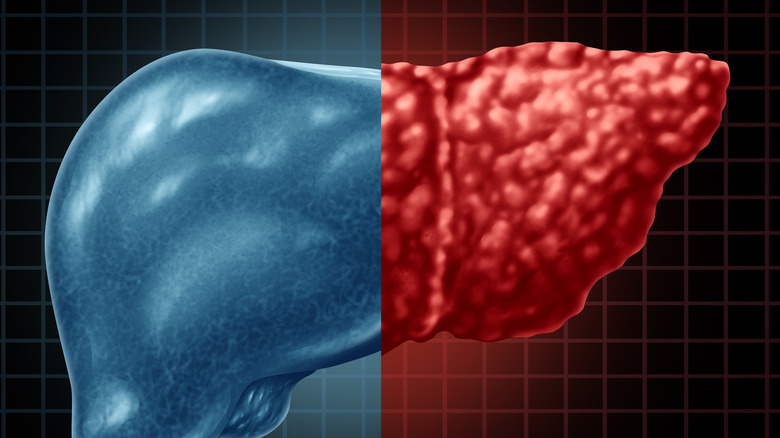Sleep apnea is characterized by abnormal breathing that stops and restarts numerous times during sleep (via the Mayo Clinic). It is a potentially serious condition that can cause low oxygen in the blood, resulting in increased blood pressure and higher risk of stroke or heart attack. Frequent loud snoring and gasping for air during sleep are among the most common symptoms. Per the National Heart, Lung, and Blood Institute, the most common type of sleep apnea is obstructive sleep apnea (OSA). In OSA, the upper airways become blocked, causing air flow to be reduced or completely halted. The other main type (central sleep apnea or CSA) occurs when the brain does not effectively send signals to the muscles involved in breathing.
The prevalence of obstructive sleep apnea is on the rise (via the NIH). Worldwide, nearly one billion people suffer from OSA, defined as having 5 or more events (breathlessness) per hour. Moderate to severe OSA (15 or more events/hour) affects 425 million adults in the age range of 30 and 69 years. The prevalence of OSA increases with age and parallels the obesity epidemic. According to the Cleveland Clinic, an overnight sleep study is used to confirm a diagnosis of sleep apnea if it is suspected from evaluation of symptoms and risk factors. Treatment options for sleep apnea include lifestyle changes, breathing devices, dental appliances, and surgery.
If left untreated, sleep apnea can cause adverse effects throughout the body (via Healthline). Keep reading to learn more about them.
Breathing difficulty

The main clinical feature of sleep apnea is disrupted breathing during sleep, which can lead to serious health problems and premature death (via the Merck Manual). Moreover, sleep apnea may also cause long-term breathing difficulty related to lung problems.
For example, the repeated episodes of low blood oxygen (hypoxia) caused by sleep apnea can increase the pressure in the pulmonary arteries (via the American Sleep Apnea Association). In addition to a considerable loss of oxygen, excessive amounts of carbon dioxide (CO2) build up in the blood as a consequence of frequent bouts of apnea (breathing stops). This imbalance of oxygen and CO2 strains the cardiopulmonary system and can cause adverse effects to the internal pressure of the lungs.
According to the Pulmonary Hypertension Association, a consensus panel of the American College of Chest Physicians found that up to 53% of people with sleep apnea also develop pulmonary hypertension (high blood pressure in the lung arteries). The low levels of oxygen during sleep cause arteries to remodel or change their structure, thus compensating for adverse conditions in order to preserve blood flow. This can lead to the development of pulmonary hypertension and other lung disorders. Shortness of breath is a common symptom of pulmonary hypertension (via the American Lung Association).
Cardiovascular problems

Per a 2024 review in the Journal of the American Heart Association, OSA is strongly correlated with the development of cardiovascular diseases such as high blood pressure, heart failure, stroke, coronary artery disease, and atrial fibrillation (AFib). In fact, OSA affects 40% to 60% of patients with cardiovascular disease. Moreover, adults with OSA have worse outcomes (e.g., death) associated with cardiovascular disease.
The drop in oxygen levels during sleep underlies the adverse cardiac effects of OSA. Oxygen deficiency leads to excessive production of free radicals that can target and damage the inner lining of blood vessels, resulting in the development of atherosclerosis (plaque buildup inside the arteries). Low oxygen also induces inflammation, a major driver of cardiovascular disease (via a 2024 study in the International Journal of Molecular Sciences).
At the molecular level, heart and blood vessel problems caused by sleep apnea may be mediated by the lack of a gaseous compound known as nitric oxide, reports a study published in a 2024 edition of Sleep Disorders. Nitric oxide is a signaling molecule that relaxes artery walls, thus promoting dilation of blood vessels and healthy blood pressure. Low levels of nitric oxide are associated with impaired functioning of the lining of blood vessels (endothelial dysfunction), a major contributor to atherosclerosis and cardiovascular disease. A 2024 systematic review and meta- analysis published in Sleep and Breathing found a strong correlation between OSA and low serum or plasma levels of nitric oxide.
High blood sugar

Dragana991/Getty Images
Elevated blood glucose levels have been shown to significantly correlate with OSA, per a 2024 study in the European Respiratory Journal. Among over 5,000 non-diabetic adults with sleep apnea, those with the most severe form of OSA had a considerably greater chance of having levels of hemoglobin A1c (average blood sugar over 2-3 months) exceeding 6.0% (within the pre-diabetic/diabetic range).
High levels of A1c are also a marker of increased risk of cardiovascular disease. Since the degree of low blood oxygen caused by sleep apnea also correlated with A1c levels in the study, low tissue concentrations of oxygen likely played a major role in the subjects’ unhealthy blood sugar levels. A link between high blood glucose levels and severe sleep apnea was also found in a group of African Americans enrolled in The Jackson Heart Study (via a 2024 article in the Journal of the American Heart Association). Insulin resistance and type 2 diabetes occur more frequently in Black people than white people.
Data from a 2024 review in the Journal of Diabetes Investigation provide convincing evidence that people with OSA have greater odds of developing type 2 diabetes than those without OSA, irrespective of age and body fat (BMI). Remarkably, OSA occurs in more than half of people with type 2 diabetes. Snoring and frequent daytime sleepiness were also linked to diabetes. Interrupted sleep and intermittent dips in oxygen levels contribute to the development and worsening of insulin resistance, a hallmark of type 2 diabetes.
Altered immune function

Juan Ci/Shutterstock
According to a 2024 review of studies published in Frontiers in Surgery, the immune response in people with sleep apnea is altered in a way that promotes a pro-inflammatory state and a malfunctioning immune system.
Increasing concentrations of proinflammatory cytokines (proteins involved in cell signaling) are found in the blood and tissues of people with OSA. For example, elevated levels of the inflammatory cytokine interleukin-6 (IL-6) coincide with the severity of OSA. The inflammatory nature of OSA is related to the chronic intermittent drop in blood oxygen levels caused by the repeated disruption of airflow during sleep. Destructive free radicals that are generated from low oxygen in organs and tissues leads to increased inflammation, a key contributor to chronic diseases such as cardiovascular disease.
Adequate sleep is vital for a healthy immune system to fight off respiratory and bacterial infections, reports another 2024 review of studies published in the International Journal of Environmental Research and Public Health. Sleep deprivation is known to suppress immune function. In fact, shorter sleep duration increases the risk of the common cold. Sleep apnea is a major cause of sleep loss. A 2024 systematic review and meta-analysis found that OSA is correlated with an increased risk of severe Covid-19 infection, ICU admission, the need for mechanical ventilation, and death.
Liver disorders

Wildpixel/Getty Images
Non-alcoholic fatty liver disease (NAFLD) is a silent epidemic and serious public health challenge affecting nearly two million people worldwide, reports a 2024 article published in Nature Reviews Gastroenterology & Hepatology.
NAFLD encompasses a spectrum of liver disorders ranging from simple fatty liver to liver inflammation (steatohepatitis) and eventually liver scarring (fibrosis). It is an important risk factor for cancer, cardiovascular disease, and type 2 diabetes. As explained in a 2024 review of studies in the American Journal of Respiratory and Critical Care Medicine, OSA is linked to the development and progression of NAFLD. Both conditions are associated with insulin resistance, inflammation, oxidative stress (free radical damage), and unhealthy levels of fats in the blood.
In people with OSA, chronic intermittent hypoxia (low blood oxygen) caused by disrupted sleep leads to low tissue oxygen, which triggers the production of damaging free radicals and systemic inflammation. This results in a state of insulin resistance, which drives the accumulation of fat in the liver. Thus, it is a hallmark of NAFLD and its progression to fibrosis.
Low libido

Prostock Studio/Shutterstock
In a 2024 study published in the journal Sleep Medicine, a significant portion of middle-aged men with untreated OSA reported a low libido. Poor sleep quality as well as older age, depression, and frequent nighttime urination were also associated with men suffering from a low libido. As noted by WebMD, men undergoing sleep studies for suspected OSA had a high rate of erectile dysfunction and sexual dysfunction, likely attributed primarily to oxygen deprivation induce by OSA.
Sexual function in women may also be affected by OSA, reports a 2024 study published in the Urology Journal. Ratings of sexual function based on a self-report questionnaire were significantly lower among premenopausal women with OSA than among those of control women without OSA. Specific indicators of sexual function were given a considerably lower score by the women with OSA. These markers of sexual function include desire, arousal, and orgasm. For good measure, sleep apnea in one partner may disturb the other partner’s sleep, as well as sex drive (via WebMD).
Daytime sleepiness/impaired cognition

Paul Bradbury/Getty Images
Excessive daytime sleepiness (EDS) is a major sign of OSA, reports a 2024 review in the Annals of the American Thoracic Society. Difficulty staying awake during the daytime can have adverse consequences with respect to safety, daily functioning, mood productivity, and quality of life. In people with OSA, daytime sleepiness raises the risk of auto accidents and work-related accidents. Evidence points to nerve damage in wake-promoting regions of the brain resulting from disrupted sleep and low oxygen levels as a potential mechanism underlying daytime sleepiness in OSA.
Another review published in a 2024 edition of Chest notes that daytime sleepiness is a sign of cognitive impairment, which occurs more frequently in elderly women with OSA than in those without OSA. Cognitive impairment is correlated with the severity of sleep apnea and low blood oxygen. Interestingly, it is the intermittent episodes of low blood oxygen (rather than sustained low oxygen) that plays a prominent role in daytime sleepiness, cognitive decline, and other adverse health effects associated with sleep apnea. Having cycles of low blood oxygen and reoxygenation is an example of a phenomenon known as ischemia-reperfusion injury. This occurs when blood flow is restored following a period of reduced blood flow, paradoxically resulting in tissue damage from increased production of oxygen free radicals (via a 2024 review in the International Journal of Molecular Sciences).
Since daytime sleepiness is one of the most common symptoms of OSA, any adult with unexplained EDS and/or fatigue should be assessed for sleep apnea (via the NIH).
Depression/anxiety

Inside Creative House/Shutterstock
As noted in a 2024 study published in the journal Sleep Medicine and Disorders, depression occurs more frequently in people with OSA than in the general population. Both OSA and depression are associated with anxiety.
Other signs of depression that overlap with symptoms of OSA include poor concentration, fatigue, low energy, and waking up in the morning not feeling refreshed. Because of these similarities, the diagnosis and treatment of each disorder can be challenging. For example, antidepressant medications are not effective in treating depression induced by OSA. Rather, these drugs can intensify OSA and may even negatively impact mood.
A 2024 review of studies in the journal Sleep Science reports that OSA is an independent risk factor for depression, and that the likelihood of a person with OSA to develop depression increases in parallel with the severity of OSA. According to one potential mechanism, sleep apnea causes a lack of blood flow and oxygen to certain regions of the brain (e.g., hippocampus) that results in damage to the area which, in turn, is linked to mood disturbance and cognitive decline.
Causes and risk factors of sleep apnea

Pathdoc/Shutterstock
Certain structural factors may contribute to narrowing or blockage of the airways in people with sleep apnea, explains the Cleveland Clinic. For example, people with a neck circumference greater than 16 inches (40 centimeters) are more prone to having thickened tissues that crowd the airways, thus restricting airflow. Other structural causes of sleep apnea include a large tongue, large tonsils or adenoids, an underbite, or an abnormally small jaw. In addition, people with genetic disorders that feature an abnormal shape of the head and neck (e.g., Down syndrome and Prader-Willi syndrome) are also at increased risk of sleep apnea.
Lifestyle factors may play a role in sleep apnea as well. In people who are overweight or obese, excess fat tissue pushes against the windpipe during sleep, disrupting breathing. Other lifestyle causes of sleep apnea include smoking, alcohol consumption, sedative use, and a supine sleeping position (via the NIH). Meanwhile, advanced age, being male, menopause, and pregnancy are non-structural factors associated with a higher risk of sleep apnea (per Medical News Today).
Allergies, sinusitis, diabetes, and thyroid problems are among a wide range of disorders that can also cause or contribute to sleep apnea. Additional medical conditions linked to sleep apnea include heart or kidney failure, stroke, and neurological disorders such as encephalitis.
Sleep apnea in children

Andrey Popov/Getty Images
Obstructive sleep apnea also occurs in children, reports the Mayo Clinic. As in adults, obstruction of the upper airways in a child partially or completely stops breathing many times over during sleep. Unlike adults, however, airway blockage in children is most often caused by enlargement of the adenoids and tonsils.
Another distinction is that behavioral (e.g., hyperactivity, inattention) and learning problems are common in children with sleep apnea, while daytime sleepiness is a prominent feature of adult sleep apnea. Obesity increases the risk of sleep apnea in both adults and children, though much more so in adults. Othe risk factors for sleep apnea in children include Down syndrome, cerebral palsy, abnormalities in the skull or face, sickle cell disease, neuromuscular disease, low birth weight, and having a family history of OSA.
Apart from behavioral problems, children with OSA often snore, and may sweat or wet the bed during sleep (per the Merck Manual). Some children may experience morning headaches or mouth breathing, while growth may be delayed in others.
Prognosis for sleep apnea

MDV Edwards/Shutterstock
With effective treatment, the prognosis for people with sleep apnea is excellent (via the Merck Manual). Treatment may modestly lower blood pressure and reduce symptoms of sleep apnea such as daytime sleepiness, snoring, and restless sleep. Other benefits of treatment include a decreased prevalence of stroke and less of a decline in renal function. Treatment of sleep apnea can also make certain conditions (e.g., heart failure, arrythmias) more manageable.
Conversely, notes the NIH, the prognosis of people with sleep apnea who do not comply with CPAP treatment is guarded. Roughly half of people instructed to use the CPAP machine quit using it within the first month. People who discontinue CPAP treatment are at increased risk of numerous adverse effects to the body. Among these negative consequences are increased risk of heart attack, stroke, pulmonary hypertension, high blood levels of carbon dioxide, low blood levels of oxygen, daytime sleepiness, and auto accidents.
According to WebMD, severe sleep apnea that is not treated shortens a person’s lifespan, to the extent that it “roughly doubles [their] risk of death.”



